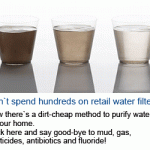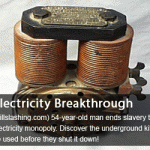One of the worst things that can happen (short of total disaster) is a long term power outage when it is below freezing. If you are smart and plan ahead, you probably have a way to heat at least a portion of your house.
But is that enough to keep your entire house heated so your water pipes don’t freeze?
Are you even thinking about your water pipes as you sit huddled together trying to keep warm?
You really should because if they burst, you are going to have a major problem once they thaw out.
Just a few simple steps can freeze proof your water pipes in a wintertime power down situation. Here they are.
Before the Big Freeze
There are several steps you should take to prepare your household plumbing before an emergency occurs. They are simple to do and all can be done by you if you have some plumbing skills.
- Insulate your pipes. Use either tube insulation or tape insulation to get a snug seal around all the pipes you can reach. This is especially important in the colder areas of your house – crawl spaces, basement and garage. This is a low cost, easy to do project and is good for anyone who lives in a winter region to do.
- Be sure that there is a drainage valve installed at the lowest point in your plumbing system to allow for complete draining in the event of an extended power outage. Installing the valve is pretty easy but it does take some plumbing skills.
- After the Power Goes Out
Once the power goes out, you have time to take care of preparing your plumbing for an extended outage. This means that you can probably wait a few hours before taking action. That will give you time to see if the power goes back on quickly or if you need to hunker down for the duration.
- If you decide that it is wise to prepare your plumbing system, here are the steps you need to take.
- Turn off the circuit breakers to your hot water heater (and hot water heating system if you have one.)
- Close the main water supply valve. This means going out to your meter head and using a tool to turn the water off at that point. This is generally a special purpose tool that can be found at your local hardware store. Alternatively, your house may be equipped with a shutoff valve at the point where the water enters the house. If possible, it is best to shut it off at the meter and then drain the system.
- Turn on all the faucets in the house. This will start the draining process. Remember that this includes the drain valve in the hot water heater (hot water heating system) and the drain valve at the lowest point in your plumbing. Once they are drained, leave them open. Also remember to turn on all the outside faucets to be sure they completely drain.
- Flush the toilets to drain the tank. Then sponge out all the water in the toilet tanks and bowls. You may want to stuff a towel into the toilet bowl(s) when you are finished to keep gases from entering the now empty toilet trap. You do not need to turn off the water supply for the toilets. They will automatically drain as part of the plumbing system drain process and your toilets will refill when the water is turned on.
- Treat your traps. Each sink shower and tub has a U shaped drainage trap that has water in it. The easiest way to treat these points is to pour a little RV antifreeze
into each sink, tub and shower. A few ounces will do the trick. Important: RV antifreeze is supposed to be nontoxic but it is still something you should take precautions with.
Notes:
- When you drain your hot water heater/hot water heating system, the water will probably still be hot and it will have a lot of water. The best way to drain them is to attach a garden hose to the drain valve and run it someplace safe and just let it drain. It will take quite a while to fully drain.
- If you have a hot water heating system that uses radiators, they may have drainage valves. If they do, you need to also open them to help drain each radiator and help drain the full system.
- When the power comes back on, close the drains on the hot water heater/how water heating system and your low point plumbing drain. Then turn on the water supply. Let the entire system bleed of air and fill before shutting off all the faucets. You will know you can shut off a faucet when water is coming from it. This process can make a lot of noise. And be sure to remember the outdoor faucets. Next, turn on the circuit breakers for your hot water heater/hot water heating system. Lastly, flush all the toilets and run all the showers and tubs to drain out the RV antifreeze.
SOURCE : http://theweekendprepper.com/do-it-yourself/how-to-keep-your-pipes-from-freezing/


